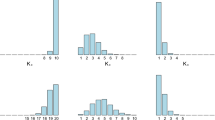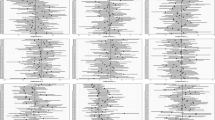Abstract
Parameter estimation for model-based clustering using a finite mixture of normal inverse Gaussian (NIG) distributions is achieved through variational Bayes approximations. Univariate NIG mixtures and multivariate NIG mixtures are considered. The use of variational Bayes approximations here is a substantial departure from the traditional EM approach and alleviates some of the associated computational complexities and uncertainties. Our variational algorithm is applied to simulated and real data. The paper concludes with discussion and suggestions for future work.










Similar content being viewed by others
References
Abramowitz M, Stegun I (1972) Handbook of Mathematical Functions with Formulas, Graphs, and Mathematical Tables, 9th edn. Dover Press, New York
Akaike H (1973) Information theory and an extension of the maximum likelihood principle. In: Second international symposium on information theory, vol 1. Springer, Berlin, pp 267–281
Andrews JL, McNicholas PD (2011) Extending mixtures of multivariate t-factor analyzers. Stat Comput 21(3):361–373
Andrews JL, McNicholas PD (2012) Model-based clustering, classification, and discriminant analysis via mixtures of multivariate t-distributions. Stat Comput 22(5):1021–1029
Andrews JL, McNicholas PD, Subedi S (2011) Model-based classification via mixtures of multivariate t-distributions. Comput Stat Data Anal 55:520–529
Baek J, McLachlan GJ (2011) Mixtures of common t-factor analyzers for clustering high-dimensional microarray data. Bioinformatics 27:1269–1276
Baek J, McLachlan GJ, Flack LK (2010) Mixtures of factor analyzers with common factor loadings: applications to the clustering and visualization of high-dimensional data. IEEE Trans Pattern Anal Mach Intell 32(7):1298–1309
Barndorff-Nielsen OE (1997) Normal inverse Gaussian distributions and stochastic volatility modelling. Scand J Stat 24(1):1–13
Baum LE, Petrie T, Soules G, Weiss N (1970) A maximization technique occurring in the statistical analysis of probabilistic functions of Markov chains. Ann Math Stat 41:164–171
Beal MJ (2003) Variational algorithms for approximate Bayesian inference. PhD thesis, University of London
Bechtel Y, Bonaiti-Pellie C, Poisson N, Magnette J, Bechtel P (1993) A population and family study of \(N\)-acetyltransferase using caffeine urinary metabolites. Clin Pharmacol Ther 54(2):134–141
Bouveyron C, Girard S, Schmid C (2007) High-dimensional data clustering. Comput Stat Data Anal 52(1):502–519
Browne RP, McNicholas PD, Sparling MD (2012) Model-based learning using a mixture of mixtures of Gaussian and uniform distributions. IEEE Trans Pattern Anal Machine Intell 34(4):814–817
Celeux G, Govaert G (1995) Gaussian parsimonious clustering models. Pattern Recognit 28:781–793
Chhikara RS, Folks JL (1989) The Inverse Gaussian Distribution: Theory, Methodology, and Applications, Statistics: Textbooks and Monographs, vol 95. Marcel Dekker Inc, New York
Corduneanu A, Bishop CM (2001) Variational Bayesian model selection for mixture distributions. Artificial Intelligence and Statistics. Morgan Kaufmann, Los Altos, pp 27–34
Dempster AP, Laird NM, Rubin DB (1977) Maximum likelihood from incomplete data via the EM algorithm. J R Stat Soc Ser B 39(1):1–38
Fraley C, Raftery AE (2002) Model-based clustering, discriminant analysis, and density estimation. J Am Stat Assoc 97(458):611–631
Franczak BC, Browne RP, McNicholas PD (2012) Mixtures of shifted asymmetric Laplace distributions. arXiv:1207.1727v3
Ghahramani Z, Hinton GE (1997) The EM algorithm for factor analyzers. Tech. Rep. CRG-TR-96-1, University of Toronto, Toronto
Hastie T, Tibshirani R (1996) Discriminant analysis by Gaussian mixtures. J R Stat Soc Ser B 58(1):155–176
Hubert L, Arabie P (1985) Comparing partitions. J Classif 2:193–218
Jordan MI, Ghahramani Z, Jaakkola TS, Saul LK (1999) An introduction to variational methods for graphical models. Mach Learn 37:183–233
Jørgensen B (1982) Statistical Properties of the Generalized Inverse Gaussian Distribution, vol 21. Springer, New York
Karlis D, Lillestol J (2004) Bayesian estimation of NIG models via Markov chain Monte Carlo methods. Appl Stoch Models Business Ind 20:323–338
Karlis D, Santourian A (2009) Model-based clustering with non-elliptically contoured distributions. Stat Comput 19(1):73–83
Lee SX, McLachlan GJ (2013) On mixtures of skew normal and skew t-distributions. Adv Data Anal Classif 7(3):241–266
Lillestol J (2000) Risk analysis and the NIG distribution. J Risk 2:41–56
Lin TI (2009) Maximum likelihood estimation for multivariate skew normal mixture models. J Multivariate Anal 100:257–265
Lin TI (2010) Robust mixture modeling using multivariate skew t distributions. Stat Comput 20:343–356
McGrory CA, Titterington DM (2007) Variational approximations in Bayesian model selection for finite mixture distributions. Comput Stat Data Anal 51:5352–5367
McLachlan GJ, Peel D (2000) Mixtures of factor analyzers. Proceedings of the seventh international conference on machine learning. Morgan Kaufmann, San Francisco, pp 599–606
McNicholas PD (2010) Model-based classification using latent Gaussian mixture models. J Stat Plan Infer 140(5):1175–1181
McNicholas PD, Murphy TB (2008) Parsimonious Gaussian mixture models. Stat Comput 18:285–296
McNicholas PD, Murphy TB (2010) Model-based clustering of longitudinal data. Can J Stat 38(1):153–168
McNicholas PD, Subedi S (2012) Clustering gene expression time course data using mixtures of multivariate t-distributions. J Stat Plan Infer 142(5):1114–1127
McNicholas PD, Murphy TB, McDaid AF, Frost D (2010) Serial and parallel implementations of model-based clustering via parsimonious Gaussian mixture models. Comput Stat Data Anal 54(3):711–723
Morris K, McNicholas PD (2013a) Dimension reduction for model-based clustering via mixtures of shifted asymmetric Laplace distributions. Stat Probab Lett 83(9):2088–2093
Morris K, McNicholas PD (2013b) Non-Gaussian mixtures for dimension reduction, clustering, classification, and discriminant analysis. arXiv:1308.6315
Morris K, McNicholas PD, Scrucca L (2013) Dimension reduction for model-based clustering via mixtures of multivariate t-distributions. Adv Data Anal Classif 7(3):321–338
Murray PM, Browne RP, McNicholas PD (2013a) Mixtures of skew-\(t\) factor analyzers. arXiv:1305.4301v2
Murray PM, McNicholas PD, Browne RP (2013b) Mixtures of common skew-\(t\) factor analyzers. arXiv:1307.5558v2
Orchard T, Woodbury MA (1972) A missing information principle: theory and applications. In: Le Cam LM, Neyman J, Scott EL (eds) Proceedings of the sixth Berkeley symposium on mathematical statistics and probability, vol 1., Theory of StatisticsUniversity of California Press, Berkeley, pp 697–715
Punzo A, McNicholas PD (2013) Outlier detection via parsimonious mixtures of contaminated Gaussian distributions. arXiv:1305.4669
Schwarz G (1978) Estimating the dimension of a model. Ann Stat 6(2):461–464
Seshadri V (1993) The inverse Gaussian distribution: a case study in exponential families. Oxford University Press, New York
Steane MA, McNicholas PD, Yada R (2012) Model-based classification via mixtures of multivariate t-factor analyzers. Commun Stat 41(4):510–523
Sundberg R (1974) Maximum likelihood theory for incomplete data from an exponential family. Scand J Stat 1:49–58
Teschendorff A, Wang Y, Barbosa-Morais N, Brenton J, Caldas C (2005) A variational Bayesian mixture modelling framework for cluster analysis of gene-expression data. Bioinformatics 21(13):3025–3033
Titterington DM, Smith AFM, Makov UE (1985) Statistical Analysis of Finite Mixture Distributions. Wiley, Chichester
Todorov V, Filzmoser P (2009) An object-oriented framework for robust multivariate analysis. J Stat Softw 32(3):1–47
Venables WN, Ripley BD (2002) Modern Applied Statistics with S, 4th edn. Springer, New York
Vrbik I, McNicholas PD (2012) Analytic calculations for the EM algorithm for multivariate skew-t mixture models. Stat Probab Lett 82(6):1169–1174
Vrbik I, McNicholas PD (2014) Parsimonious skew mixture models for model-based clustering and classification. Comput Stat Data Anal 71:196–210
Waterhouse S, MacKay D, Robinson T (1996) Bayesian methods for mixture of experts. In: Advances in neural information processing systems, vol 8. MIT Press, Cambridge
Wolfe JH (1963) Object cluster analysis of social areas. Master’s thesis, University of California, Berkeley
Author information
Authors and Affiliations
Corresponding author
Additional information
This work was supported by a Postgraduate Scholarship from the Natural Sciences and Engineering Research Council of Canada, an Early Researcher Award from the Ontario Ministry of Research and Innovation, and the University Research Chair in Computational Statistics. The authors gratefully acknowledge the very helpful comments of three anonymous reviewers and a guest editor.
Rights and permissions
About this article
Cite this article
Subedi, S., McNicholas, P.D. Variational Bayes approximations for clustering via mixtures of normal inverse Gaussian distributions. Adv Data Anal Classif 8, 167–193 (2014). https://doi.org/10.1007/s11634-014-0165-7
Received:
Revised:
Accepted:
Published:
Issue Date:
DOI: https://doi.org/10.1007/s11634-014-0165-7




